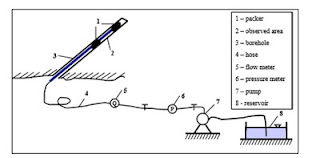Read Time:4 Minute, 55 Second
Coal extraction causes strata deformation and failure which may enhance hydraulic conductivity in the surrounding strata. Therefore, it is desirable to accurately determine pre- and post-mining hydraulic conductivities in the overburden and underlying strata of the coal seam. To measure the hydraulic conductivity in the underlying strata, boreholes are drilled pre-mining in underground roadways for observation. In each borehole, water injection and a number of well logging techniques (such as electric resistivity, sonic log, acoustic emission, and hole televiewer, etc.) are used to determine rock strength, borehole fissure, and changes in hydraulic conductivity.
Figure 10.1 gives a schematic diagram of a water injection instrument (Zhang and Zhu 1994). The key technique during measurements is to control the injection pressure. The pressure should not be high enough to create new fractures in the strata, since the experiment is to determine the changes in hydraulic conductivity induced by mining. Therefore, the injection pressure should not exceed the least principal stress of the surrounding strata. Figure 10.2 shows the observing borehole locations and layout in Xingtai coal mine. In-situ stresses in this area were: V v = 7.4 MPa, V h = 4.5 MPa. The roadway in Fig. 10.2 was located 36 m below the mining face and four boreholes were drilled at different angles. The water injection instrument described in Fig. 10.1 was applied to measure the flowrate of water injection pre- and post-mining, using an injection pressure of 0.35 – 0.5 MPa. The water injection along each borehole was conducted by pumping water into the instrument, then into the borehole. The measurements were taken in each hole at different sections throughout the borehole and at different times.

Figure 10.3 presents the measured pre-mining and post-mining flowrate of water injection in Hole 1 (refer to Fig. 10.2). Note that in this context pre-mining corresponds to a state before the mining face passes the borehole, and post-mining means after the mining face passes the borehole. Before the mining face passed Hole 1 (in pre-mining the mining face was 32 m away from the borehole), the injection rate was zero from 53 to 68 m in the inclined borehole. This means that the strata in this area were impermeable. However, when the mining face passed the borehole, the injection rate (refer to Fig. 10.3 for post-mining at 19 and 63 m) increased dramatically, and the strata in some areas changed from being impermeable to permeable. Since the borehole wall collapsed by mining when the mining face passed 63 m from the borehole, water injection data could not be obtained after 60 m from the borehole opening. The borehole collapse in post-mining illustrates that the borehole was seriously damaged, and that rocks around the borehole failed due to mining.
Figure 10.4 plots the increments of water injection rates after mining, which were obtained by subtracting the pre-mining injection rates from those of the post-mining (Zhang 2005). These increments represent injection rates caused by permeability changes induced by coal extraction. Figure 10.4 shows that along the inclined borehole from 43 m to 72 m (the borehole end), the injection rate increases compared to the pre-mining (insitu) state. Therefore, the strata in this area were fissured by mining, and this fractured area is defined as the water-conducting failure zone. Using the same method to analyze the observed data from all boreholes, the mining-induced water-conducting failure zone can be obtained. This failure zone is of critical importance for mine design and water inrush prevention for mining over aquifers. Figure 10.5 shows the changes of the average water injection rate in the seam floor of 10 m deep from the seam in the Xingtai coal mine. The injection rate clearly increases compared to the unmined area. The injection rate decreases inside the abutment. This decrease is due to stress concentration and high abutment pressure occurring in this area, causing the fractures to close.
Figure 10.6 displays the changes of the injection rates with distance of mining advance for two different depths beneath the coal seam in Wangfeng coal mine, Hebei Province. It clearly shows that in the mined area the injection rate increases significantly compared to the unmined area. It also can be seen that due to coal extraction the water-conducting capacity increases in the floor strata, and this water-conducting capacity decreases as the distance from coal seam to the floor strata increases. This indicates that the closer the strata is to the extracted seam, the higher the permeability in the seam floor. It is also noticeable that the injection rate decreases inside the abutment. This decrease is due to the fact that stress concentration and high abutment pressure occurred in this area cause the fractures to be closed.
Field observations have shown that characteristics of failures in the floor strata are considerably different for different inclinations of the extracted seams. For flat or slightly inclined seams (dip angle, D < 25q), the profile of the water-conducting failure zone is broad in section with extended lobes, and the maximum failure depth occurs beneath the headgate and tailgate, respectively shown in Fig. 10.7 (Fengfeng Mining Bureau et al. 1985). For inclined seams (25q < D < 60q), the failure zone propagates downwards in an asymmetric manner in the dip direction, as shown in Fig. 10.8 (Huainan Mining Bureau et al. 1983). The extent of the failure zone increases gradually from updip to downdip, and the maximum failure depth appears in the floor strata beneath the area around the lower gate. For steeply inclined seams (60q < D < 90q), the failure zones in the floor strata are opposite to the inclined seams, i.e., the maximum failure depth appears in the strata beneath the area around the upper gate (Zhang 2005).